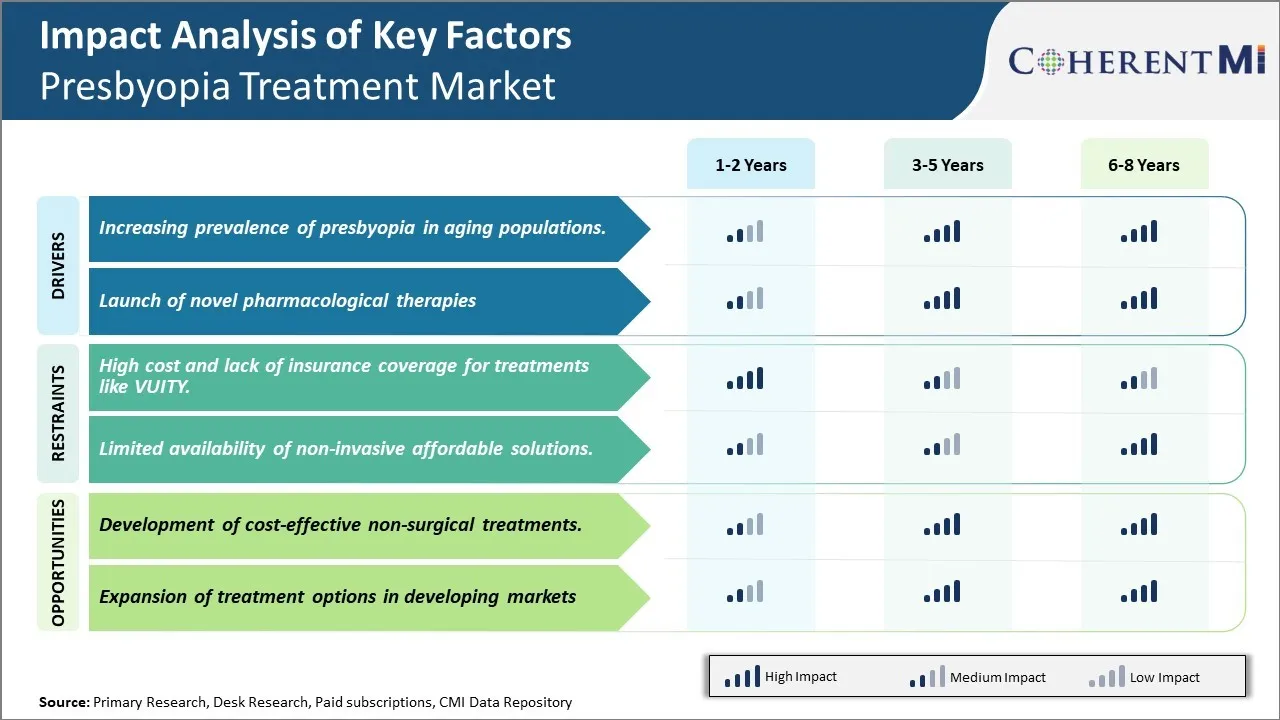Presbyopia Treatment Market Trends
Market Driver - Increasing prevalence of presbyopia in aging populations
As the average human lifespan increases globally, the percentage of the population aged over 50 years is set to rise dramatically in the coming years. Presbyopia is a natural age-related condition characterized by the gradual loss of ability of the eye to focus on near objects, primarily caused due to the hardening of the eye's natural lens. It is an almost inevitable occurrence affecting nearly all adults by the age of 45-50 years. With continued advancements in healthcare and standard of living, more people are living longer and surviving well into their senior years when presbyopia commonly begins to affect individuals.
The number of presbyopia cases has been rising in sync with the worldwide growth of the geriatric demographic. As per estimates, over 1.8 billion people suffered from presbyopia in 2020. This number is expected to surge remarkably to touch 2.1 billion by 2030. Even in developing nations which are witnessing accelerated aging of their populace, presbyopia cases have multiplied at a frenetic pace. For example, the percentage of the Indian population aged above 50 years is projected to increase from 10% in 2021 to over 20% by 2050. This will translate to a huge presbyopia patient pool in the country in the coming decades.
Aging populations in major economic blocs like North America, Western Europe, and East Asia form hotspots with highest presbyopia prevalence globally. Their large base of elderly consumers is driving consistent demand for vision correction aids. At the same time, even relatively younger developing economies will contribute significantly to the disease burden owing to their demographic dividends. With no options available as of now to reverse the condition, established treatments aim to compensate for the presbyopic vision impairment. Newer therapeutic interventions being explored can potentially help a large section of global aging population in managing this debilitating optical problem.
Market Driver - Launch of novel pharmacological therapies
The inability to clearly see close objects is a frustrating effect of presbyopia that diminishes quality of life. Reading, sewing, using smartphones etc. all become difficult tasks without appropriate vision aids. Existing options like reading glasses, bifocal and varifocal lenses have achieved mass adoption but address symptoms, not the cause. Pharmaceutical companies have remained actively engaged in R&D to develop true disease-modifying drugs that can potentially restore the elasticity of the crystalline lens or halt its hardening process.
Some have recently announced positive results from late-stage clinical trials of new presbyopia therapies administered via eye drops. If approved, these may become worldwide commercially available within the next 1-2 years. Compared to perpetual dependency on glasses, an effective medication taken occasionally could offer greater relief and adherence for patients. Eye care specialists also view pharmacological interventions as a more long-lasting solution than current device-based workarounds. Their widespread physicians' recommendation and prescription can rapidly push the novel drugs into the mainstream.
Early success of such break-through research outcomes has renewed hopes of finally defeating presbyopia through medicine rather than sustaining its impact. It may encourage more investment into this avenue of treatment and discovery of alternate molecules. The anticipated approval and launch of first-in-class topical therapies has already created buzz within the medical community as well as among presbyopia sufferers. Their accessibility without significant hassles can significantly expand the reach of these innovative therapies.

Market Challenge - High cost and lack of insurance coverage for treatments like VUITY
High cost and lack of insurance coverage for treatments like VUITY. The cost of current prescription eye drops and lens options to treat presbyopia remains prohibitively high for many patients. For example, pilocarpine eye drops need to be applied several times a day and cost hundreds of dollars per year without insurance. Newer options like VUITY eye drops provide relief from reading glasses within 15 minutes of application but come with a price tag of $80 per pair of drops. Many private and public insurance plans do not provide coverage for vision conditions classified as "lifestyle" issues rather than medical problems. With over half the global population experiencing presbyopia by the age of 45, the high costs pose a major barrier for widespread adoption of presbyopia treatments. Manufacturers will need to lower prices significantly or develop lower-cost generic versions to make therapies affordable and accessible to more consumers.
Market Opportunity - Development of cost-effective non-surgical treatments
The market presents major opportunities for companies that can develop new non-surgical treatment options that are affordable and convenient for patients. There is significant scope to augment current eye drop formulations with more effective ingredients or delivery mechanisms that provide relief for a full day with just one application. Researchers are also exploring novel options like bespoke contact lenses tailored with presbyopia corrections or low-cost light therapies. With billions of presbyopia patients worldwide, even a small capture of this largely untreated market presents massive revenue potential. Lowering costs will scale presbyopia treatments from an affordability perspective while innovation will drive greater adherence and compliance. This focus on affordability and convenience holds the key to fully tapping into the growth opportunities within presbyopia management.